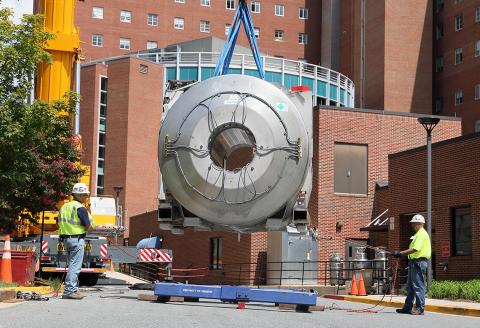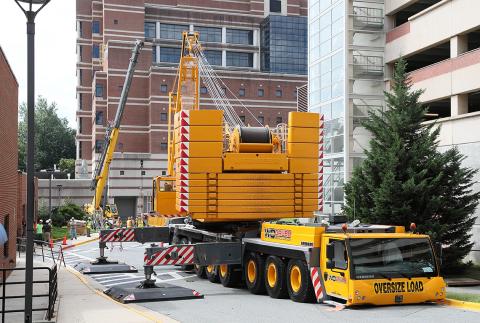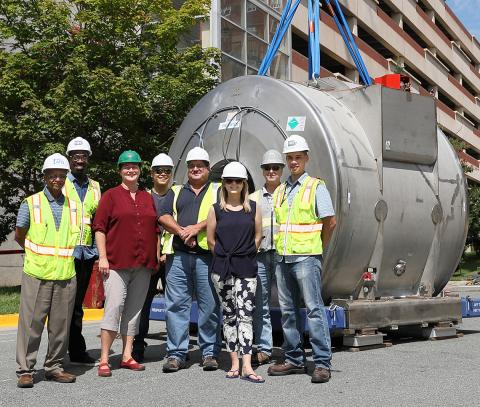19-Ton Magnet Augments NIH MRI Facility

Photo: Chia-Chi Charlie Chang
Lowered through a hatch in the roof of the NIH MRI Research Facility (NMRF) on Aug. 25—with only an inch to spare on each side—was the ninth and newest member of a family of huge magnets used to conduct magnetic resonance imaging studies in humans. The 7-Tesla, 19-ton behemoth required a 600-ton capacity crane, buttressed by a 75-ton support crane, to swing the magnet 170 feet from a flatbed truck parked on South Dr. to its new home in Bldg. 10 NMR Center, Rm. B1D305.
“It took 19 tractor-trailers to deliver the cranes and magnet to campus, but all went smoothly that sunny Saturday morning,” said Dr. Joelle Sarlls, a staff scientist in the NMRF. The sizeable effort was coordinated by Daniel Lid, a project officer in the Office of Research Facilities.
The NMRF is a trans-NIH facility within the In Vivo NMR (nuclear magnetic resonance) Center, which first opened in 1987 as an appendage to the southwest side of Bldg. 10. Presently, the center boasts active research programs from NIMH, NINDS, NIAAA, NHLBI and the Clinical Center’s radiology department, as well as the NMRF and another trans-NIH facility, the Mouse Imaging Facility.
In 1987, NIH hosted its first human research MRI magnet, a 1.5-Tesla machine made by GE. Because the field generated by the magnet was so large, GE designed an add-on to Bldg. 10 that has grown into the present NMR Center. The location outside of the main part of Bldg. 10 shielded the machine from harming any metal-bearing neighbors, said Dr. Alan Koretsky, NMRF director for the past 19 years who has recently stepped out of his role as NINDS scientific director.
The new 7T magnet is self-shielded, as are most new-generation magnets, so that the large center—initially pioneered by former Office of Research Services director (and NIDDK scientist) Dr. Ted Becker—can continue to accommodate more and stronger MRI fields without having to grow physically. Despite the continuous improvement in magnet technology, the NMR Center has expanded four times during its 31-year lifespan to accommodate the growing need for research MRI by more and more institutes within the Intramural Research Program.
The tesla is a unit of magnetic field strength, adopted internationally in 1960 in honor of Nikola Tesla, a Serbian American inventor. One T equals 10,000 gauss. One talks T only at industrial-grade, or research, applications; a strong refrigerator magnet is about 100 gauss.

Photo: Chia-Chi Charlie Chang
The higher the field strength of an MRI magnet, the sharper the resolution of images of interest to researchers, of whom several hundred work under the umbrella of the In Vivo NMR Center. “It’s like a whole institute of activity, with hundreds of researchers using the resources,” notes Koretsky.
The NMRF was the first of what are now 7 trans-NIH facilities that are overseen by NIH deputy director for intramural research Dr. Michael Gottesman and the scientific directors; they make special resources available to NIH scientists. The In Vivo NMR Center was also a model for how to integrate the research of multiple institutes, Koretsky added. “The Porter Neuroscience Research Center is a most recent example of integrating research across multiple institutes that was influenced by the NMR Center—but the NMRF and In Vivo NMR Center was once unique.”
Begun as a joint effort of NINDS, NIAAA, NHLBI (Laboratory of Cardiac Energetics, headed by Dr. Robert Balaban), NCRR and CC radiology (Laboratory of Diagnostic Radiology Research, headed by Dr. Joseph Frank), the In Vivo NMR Center has added research partners over the years, including NIMH, NCCIH, NEI and NCI. The users of the NMRF paid for the new 7T, helped by the NIH Director’s Challenge Innovation Award Program. “It is very rare to find that many institutes that contribute to a single endeavor because they want to,” said Koretsky. “Sometimes 2 or 3 ICs will do things, but to get 5 or 6 so readily aligned is unusual.”

Photo: Chia-Chi Charlie Chang
In addition to the new 7T magnet, which cost about $6.5 million, the center has had two other 7Ts. The first was very developmental—funded by NINDS and NIMH—and few could use it due to the early-stage nature of the project, Koretsky said. The first 7T was replaced with a second-generation 7T MRI that has found widespread use by investigators in NIMH and NINDS as part of the joint NIMH/NINDS Functional MRI Facility in the NMR Center. The center also has 7 3-Tesla magnets. An 11.7T magnet is on order for delivery later this year; the biggest magnet currently in use for human studies is 10.5T, at the University of Minnesota.
Institutes with major research programs in the NMR Center accommodate research partners not only at NIH, but also at Suburban Hospital, Children’s National Medical Center and Washington Hospital Center, Koretsky noted.
“MRI images with improved signal-to-noise ratio and/or resolution can be obtained with scanners operating at higher field strengths,” explained Dr. S. Lalith Talagala, NMRF technical director. “Therefore, the new 7-Tesla scanner will allow investigation and understanding of anatomical and functional changes due to brain abnormalities at finer detail than possible with 3-Tesla scanners. The new scanner represents the third generation of 7-Tesla scanners and has been approved by the FDA. Therefore, the new scanner will be more robust and easy to use.”

Photo: Chia-Chi Charlie Chang
NIH is one of the world’s cradles of NMR expertise, making not only scientific and clinical advances, but also technical developments in the MRI systems themselves, said Koretsky. “There are only a handful of places in the world that have as much NMR expertise as we do.”
Fifteen years ago, NIH got the third 7T magnet ever made. This first-generation machine, made by GE, required 300 tons of steel shielding.
“Interesting results with that led to the development of a second-generation 7T, with active magnetic shielding—we de-risked the technology,” said Koretsky. “This work demonstrated the need for another 7T for the broader NIH community.”
The new machine, built by Siemens, represents the third-generation of 7T magnets. It is expected to perform in the proud tradition of its smaller, lower-field forbears: NIH acquired one of the first 4T MRI machines in the world when it debuted and pioneered GE’s first 3T machine years ago. 3T MRI is now a standard around the world.
“We fully expect 7T will find widespread use and hopefully the same will happen at 11.7T,” Koretsky said.
“We have CRADAs [cooperative research and development agreements] with all three major vendors of MRI machines—Siemens, Philips and GE,” he continued. “These are critical for a large number of applications. MS [multiple sclerosis] trials have been pioneered at the NMR center, as well as important functional imaging work—watching the brain work, for example. We have an innovative NHLBI heart-imaging program right now. A lot of fundamental things have been pioneered here…I’m honored to be a part of it. We know we’re in a special place.”
Koretsky says he recently stepped aside as NINDS scientific director to pursue more research as a principal investigator: “All these cool new magnets are coming—I want to get back to science.”
The new 7T machine should be ready for users before the end of the year, said Sarlls.
“Initially, the institutes that contributed to the purchase of the scanner will have access to it,” noted Talagala. “However, any NIH investigator will be able to request time to use the new scanner for suitable protocols.”
Asked if the new magnet was attracting enthusiasm in the research community, Sarlls replied, “Oh, definitely.”
